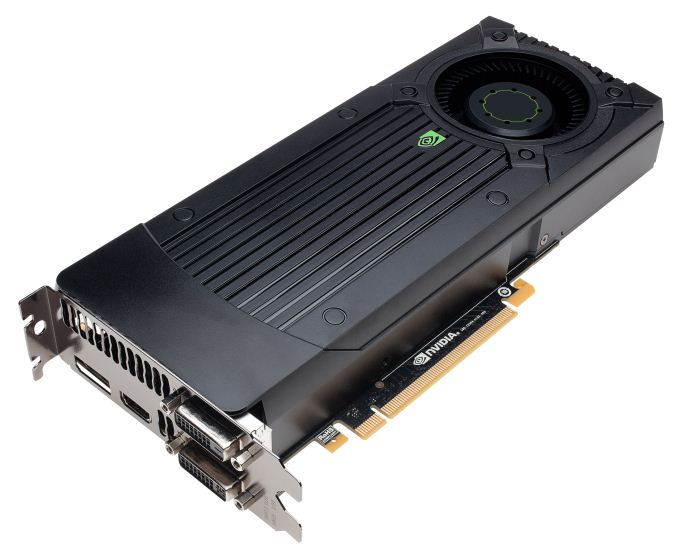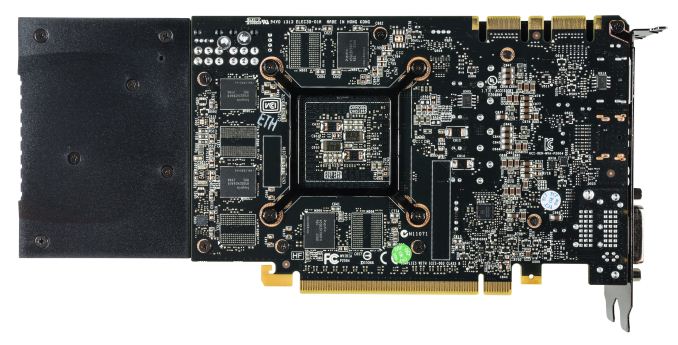NVIDIA GeForce GTX 760 Review: The New Enthusiast Kepler
by Ryan Smith on June 25, 2013 9:00 AM ESTMeet the GeForce GTX 760
As we mentioned earlier, due to its 170W TDP the GTX 760 is essentially a drop-in replacement for the GTX 670 in board designs. Even NVIDIA’s reference design reflects this, with the reference GTX 760 being based on the reference GTX 670’s cooler and PCB. Consequently there’s not much to say about the GTX 760’s design that we haven’t said before. If you’ve seen a GTX 670 then you’ve seen a GTX 760, down to the last screw. For consistency we’ll quickly go over the GTX 760’s design, but this is generally a rehash of what we’ve already said about the GTX 670.
Like GTX 670 before it, GTX 760 is another “small” GK104 design. The complete card is 9.5” long, however the actual PCB is far shorter at only 6.75” long, 3.75” shorter than the GTX 770’s PCB. In fact it would be fair to say that rather than strapping a cooler onto a card, NVIDIA strapped a card onto a cooler. Meanwhile we see that once again NVIDIA is using Hynix R0C (6GHz) GDDR5 RAM here.
The cooler itself is fairly simple, utilizing an aluminum heatsink melded with a copper base plate. A separate heatsink covers the VRM circuitry – once again mounted at the front of the card – while the fan hangs off of the rear of the card. This unfortunately is the same fan as on the GTX 670, which means it makes a faint grinding sound at low RPMs. This design has proven more than adequate for the GTX 670s, though it does leave some room for NVIDIA’s partners to improve on overall cooling performance, especially with open air coolers.
Elsewhere at the top of the card we’ll find the PCIe power sockets and SLI connectors. Two 6-pin PCIe sockets provide the necessary external power, while a pair of SLI bridge connectors at the other end allow for up to 3-way SLI. NVIDIA’s standard I/O configuration also makes an appearance here, offering 2x DL-DVI, 1x HDMI, 1x DisplayPort 1.2.
Looking at clockspeed bins for a moment, it comes as no great surprise that like the GTX 770, the GTX 760 operates at 1.2v at its highest stock clockspeed bin. The higher voltage versus the 1.76v limit on the 600 series causes power consumption to jump up more rapidly at the highest bins, but is necessary to unlock the 1100MHz+ clockspeeds the card is capable of.
| GeForce Clockspeed Bins | ||||
| Clockspeed | GTX 770 | GTX 760 | ||
| 1162MHz | N/A | 1.212v | ||
| 1149MHz | 1.212v | 1.2v | ||
| 1136MHz | 1.2v | 1.187v | ||
| 1123MHz | 1.187v | 1.162v | ||
| 1110MHz | 1.162v | 1.15v | ||
| 1097MHz | 1.15v | 1.137v | ||
| 1084MHz | 1.137v | 1.125v | ||
| 1071MHz | 1.125v | 1.112v | ||
| 1058MHz | 1.112v | 1.1v | ||
| 1045MHz | 1.1v | 1.087v | ||
Finaly, for overclockers there is one further bin (1162MHz) available via overvolting to 1.212v. The maximum power target meanwhile is 115%, for a final power limit of 195W.
















110 Comments
View All Comments
DanNeely - Tuesday, June 25, 2013 - link
The 8800 Ultra was a $650 card. Ignoring the Titan we're back where we were 7 years ago.nsiboro - Tuesday, June 25, 2013 - link
AMD delaying Sea Island until Q3'2013...I just feel someone over @AMD is crazy and didn't think thru end users' point of view.
With the release of Haswell, many will be putting together new boxes and the "new" GPU they'll get will be gtx760/770/780. AMD losing fans and revenue... *sigh*
silverblue - Tuesday, June 25, 2013 - link
I'm not sure I follow. Haswell doesn't appear to have amazed that many people - you could get away with an SB or IB build which overclock enough to make up the performance difference. If you already have one of those, with proper cooling you don't need to save money for a marginally better CPU - spend it on graphics instead.DanNeely - Tuesday, June 25, 2013 - link
It's not the SB/IB people upgrading; it's those of us with first generation i5/i7 systems or even older core 2 quads pulling the trigger now. AMD is out of the race except at the bottom and it's probably going to be two more years before Intel offers anything else worth mentioning on the desktop. (No socketed Broadwell chips, and assuming IVB-e and Haswell-e are as underwhelming at the $3xx pricepoint as SB-e is.)Dark_wizzie - Tuesday, June 25, 2013 - link
I wished it included a benchmark with Skyrim on 2560x1440, with the hardcore texture mods on, AA/AS on pretty high with Ultra. Debating between this ($250), 7970... ($310!!!), 770 ($400)Ryan Smith - Tuesday, June 25, 2013 - link
You request will be taken under consideration, but I'll tell you right now that you shouldn't expect it to happen. One of the tenets of our testing methods is that we don't test with mods; they're often not optimized (or worse, optimized only for the developer's system) and frequently updated (making our benchmarks useless). Plus the number of users on any given mod is very low, which would mean our benchmarks wouldn't be very applicable to most of our readers.edlee - Tuesday, June 25, 2013 - link
something tells me if you SLI two GTX 760 it would destroy the GTX 780 at a lesser pricexTRICKYxx - Wednesday, June 26, 2013 - link
Google some benchmarks. It goes toe-to-toe with the GTX 690 and Titan in every game I've seen. All for $500... Good deal!GTan - Tuesday, June 25, 2013 - link
Hopefully I will be building my first PC ever in a few weeks, I'm glad that Nvidia released the 760, since the 770 at $400+ is too expensive for me. My budget for my PC is $800-900. I was originally 90% sure I was gonna buy the GTX 760, $250 is a great price, but now since I've seen deals for the 7970 for as low as $300, I'm wondering is it worth it for pay a extra $50 for the 7970 (plus the 4 games). End question, what is a better value for the newb PC builder: a $250 GTX 760 or a $300 7970? Thanks!thesavvymage - Tuesday, June 25, 2013 - link
if you want the games, 7970. If not, id go wit hthe 760 for being quieter and using less power